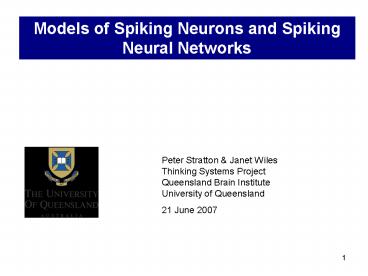A1260948126OiwKt - PowerPoint PPT Presentation
1 / 19
Title:
A1260948126OiwKt
Description:
1. Models of Spiking Neurons and Spiking Neural Networks. Peter Stratton & Janet Wiles ... Electronic version of the figure and reproduction permissions are freely ... – PowerPoint PPT presentation
Number of Views:39
Avg rating:3.0/5.0
Title: A1260948126OiwKt
1
Models of Spiking Neurons and Spiking Neural
Networks
Peter Stratton Janet WilesThinking Systems
ProjectQueensland Brain InstituteUniversity of
Queensland 21 June 2007
2
- Izhikevich Spiking Neuron Model (2003)
- Claimed to be as realistic as Hodgkin-Huxley
neurons. - As computationally efficient as simple
integrate-and-fire.
Izhikevich, E. M. (2003). "Simple model of
spiking neurons." IEEE Transactions on Neural
Networks 14(6) 1569-1572.
3
Electronic version of the figure and reproduction
permissions are freely available at
www.izhikevich.com
4
2 Variables v Membrane potential. u Membrane
Recovery variable, giving -ve feedback to v
(higher value means neuron less likely to fire),
representing Na and K ionic currents. 4
Parameters c Reset value for v higher value
means easier / more likely to fire again. a
Speed of recovery of u higher value means faster
recovery. b Sensitivity of u to v higher values
tightly couple the 2 variables resulting in
possible sub-threshold oscillations and low
threshold spiking. d Additive reset value for u
higher value means harder / less likely for
neuron to fire again.
5
Izhikevich, E. M. (2004). "Which model to use for
cortical spiking neurons? IEEE Transactions on
Neural Networks 15(5) 1063-1070.
6
Small Spiking Network Simulation
Input Current (I)
Interneuron
Pyramidal cell (uninhibited)
Pyramidal cell (inhibited)
(10 ms)
Pyramidal cell (conjunction)
Pyramidal cell (delayed conjunction)
7
Small Spiking Network Simulation no input
8
Small Spiking Network Simulation
9
Small Spiking Network Simulation
10
Small Spiking Network Simulation
11
Large Spiking Network Simulation
- 1000 fully connected neurons.
- Exhibits alpha (8-10 Hz) and occasionally gamma
(40 Hz) oscillations. - Simulates 106 connections in real-time using
Matlab (3 GHz CPU).
12
Spiking Network Simulation
- Network behaviour on one trial for slightly
increased mean synaptic strength and slightly
decreased mean thalamic input.
13
Heat Map Metrics
Total Number of Spikes in 1000ms in this case
874 total spikes.
Dominant Oscillation Frequency highest peak in
the Discreet Fourier Analysis of the Spikes /
millisecond graph in this case 8Hz.
Structure Score (kurtosis skewness) of the
Spikes / millisecond histogram in this case
28.4.
14
Structure Score examples
A 2.5
B 36.5
C 7.1
D 52.3
15
Phase Space Visualisations
Structure Score
D
C
B
A
16
Phase Space Visualisations
Total Number of Spikes in 1000ms
Dominant Oscillation Frequency
Structure Score
Average value over 500 trials
D
D
D
C
B
C
B
C
B
A
A
A
Coefficient of Variation
D
D
D
C
B
C
B
C
B
A
A
A
17
Phase Space Visualisations
Total Number of Spikes in 1000ms
Dominant Oscillation Frequency
Structure Score
Average value over 500 trials
C
B
C
B
C
B
A
A
A
Coefficient of Variation
C
B
C
B
C
B
A
A
A
18
What Happens in a Phase Change
- Number of Spikes distribution over 1000 trials
for - left - Izhikevichs parameters (synaptic weight
0.5, thalamic input 5) - right average synaptic weight increased to 0.6
19
STDP leading to nested Delta (2-4 Hz) and Gamma
(30-100 Hz) oscillations
Izhikevich, E. M. (2005). "Polychronization
Computation with Spikes." Neural Computation
18(2) 245-282.































